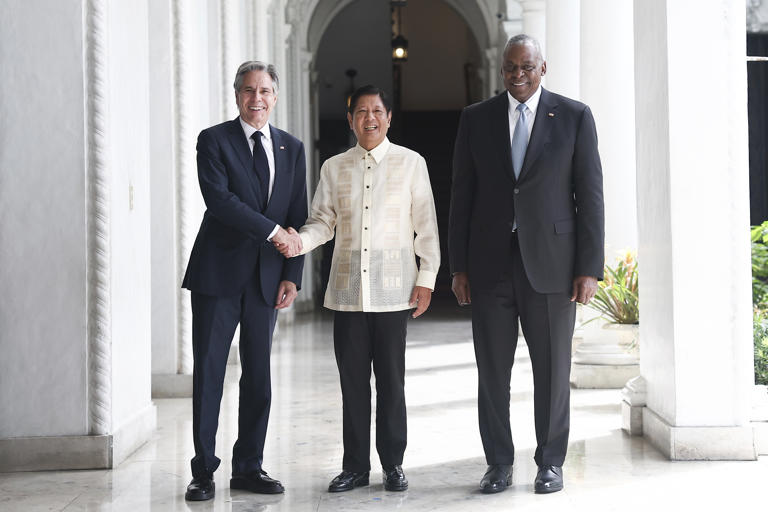U.S. Military Funding and Strategic Support
In a pivotal move to bolster regional security and fortify its strategic partnership with the Philippines, the United States has announced a $500 million military aid package during the visit of U.S. Secretary of State Antony Blinken and Defense Secretary Lloyd Austin to Manila. This substantial funding aims to strengthen Philippine defense capabilities amid escalating tensions in the South China Sea and growing concerns over China’s assertive actions in the Indo-Pacific region. A senior Philippine official revealed that the funding is a crucial step as “China’s increasingly aggressive actions in the region will not stop.”
The aid package represents a significant commitment from the U.S. to enhance the Philippines’ military infrastructure and capabilities. It includes financial support for various Philippine Navy projects and significant upgrades to military bases across the country. Notably, approximately $125 million of this allocation will be used for construction and improvements at bases where U.S. forces are stationed under the 2014 Enhanced Defense Cooperation Agreement (EDCA). This agreement allows U.S. troops greater access to Philippine military installations and underscores the deepening of defense ties between the two nations.
Diplomatic Meetings and Strategic Dialogues
During their visit, Blinken and Austin met with Philippine President Ferdinand Marcos Jr., who has been instrumental in strengthening the strategic alliance between the U.S. and the Philippines. Marcos has actively sought to reinforce this partnership in response to increased hostilities with Chinese forces, particularly in contested areas like the South China Sea. In their discussions, Marcos emphasized the importance of continuous and flexible communication to address regional challenges and ensure a robust defense strategy.
Blinken and Austin also extended their condolences to the Philippines for the recent destruction caused by typhoon-worsened monsoon rains, reflecting the U.S.’s commitment to humanitarian aid alongside military support. Their visit highlighted the comprehensive nature of the alliance, encompassing not only security but also economic and humanitarian dimensions.
Strategic and Defense Initiatives
- General Security of Military Information Agreement (GSOMIA): A key focus of the visit was the advancement of negotiations on the General Security of Military Information Agreement (GSOMIA). This proposed pact is designed to enhance U.S.-Philippines military cooperation by facilitating the exchange of high-level intelligence and advanced weaponry, including missile systems. The agreement aims to ensure that sensitive information and technology are handled securely, preventing unauthorized leaks. This pact would significantly elevate the Philippines’ defense capabilities, addressing previous limitations experienced during critical military operations, such as the 2017 siege of Marawi by Islamic State-aligned militants.
- Temporary Resupply Arrangement: Recent developments included a temporary arrangement between the Philippines and China to prevent violent clashes similar to the June 17 incident at the Philippine-occupied Second Thomas Shoal. This arrangement allowed Philippine forces to resupply and rotate personnel without encountering confrontations with Chinese forces. Although this agreement represents a temporary de-escalation, Philippine officials have reiterated their commitment to strengthening territorial defense with ongoing U.S. support and the formation of new security alliances.
Bipartisan U.S. Support and Future Prospects
Philippine Ambassador to the U.S. Jose Manuel Romualdez assured that U.S. support for the Philippines remains unwavering and bipartisan, regardless of the outcome of the upcoming U.S. presidential election. This assurance comes amid concerns about potential shifts in U.S. foreign policy depending on the next president, especially regarding former President Donald Trump’s stance on international relations. Romualdez emphasized that both Republican and Democratic factions in the U.S. Congress are committed to supporting the Philippines, ensuring continuity in the strategic partnership.
Expanding U.S. Military Presence: Under President Marcos’ administration, there has been a notable expansion of U.S. military presence in the Philippines. Marcos approved the enlargement of U.S. access to four additional Philippine military camps and oversaw the largest joint military exercises between Filipino and U.S. forces to date. These actions have drawn criticism from China, which views the increased U.S. military footprint in the region as a threat to regional peace and stability. Nevertheless, Marcos and his administration have maintained that such measures are necessary to safeguard Philippine territorial interests and national security.
Looking Ahead: The $500 million military aid package and the potential doubling of this funding next year signify a deepened commitment to the U.S.-Philippines alliance. The talks and agreements reached during Blinken and Austin’s visit underscore a strategic pivot towards enhancing military cooperation and addressing regional security challenges. As the geopolitical landscape in the Indo-Pacific continues to evolve, the strengthened partnership between the U.S. and the Philippines will play a crucial role in maintaining stability and countering aggressive regional actors.
In conclusion, the recent developments in U.S.-Philippines relations reflect a robust and multi-faceted strategic partnership designed to address current and future security challenges. The significant military aid, proposed agreements, and expanded military cooperation represent a strategic investment in the defense capabilities of the Philippines, reinforcing the long-standing alliance between the two nations amidst a complex and shifting geopolitical environment.
